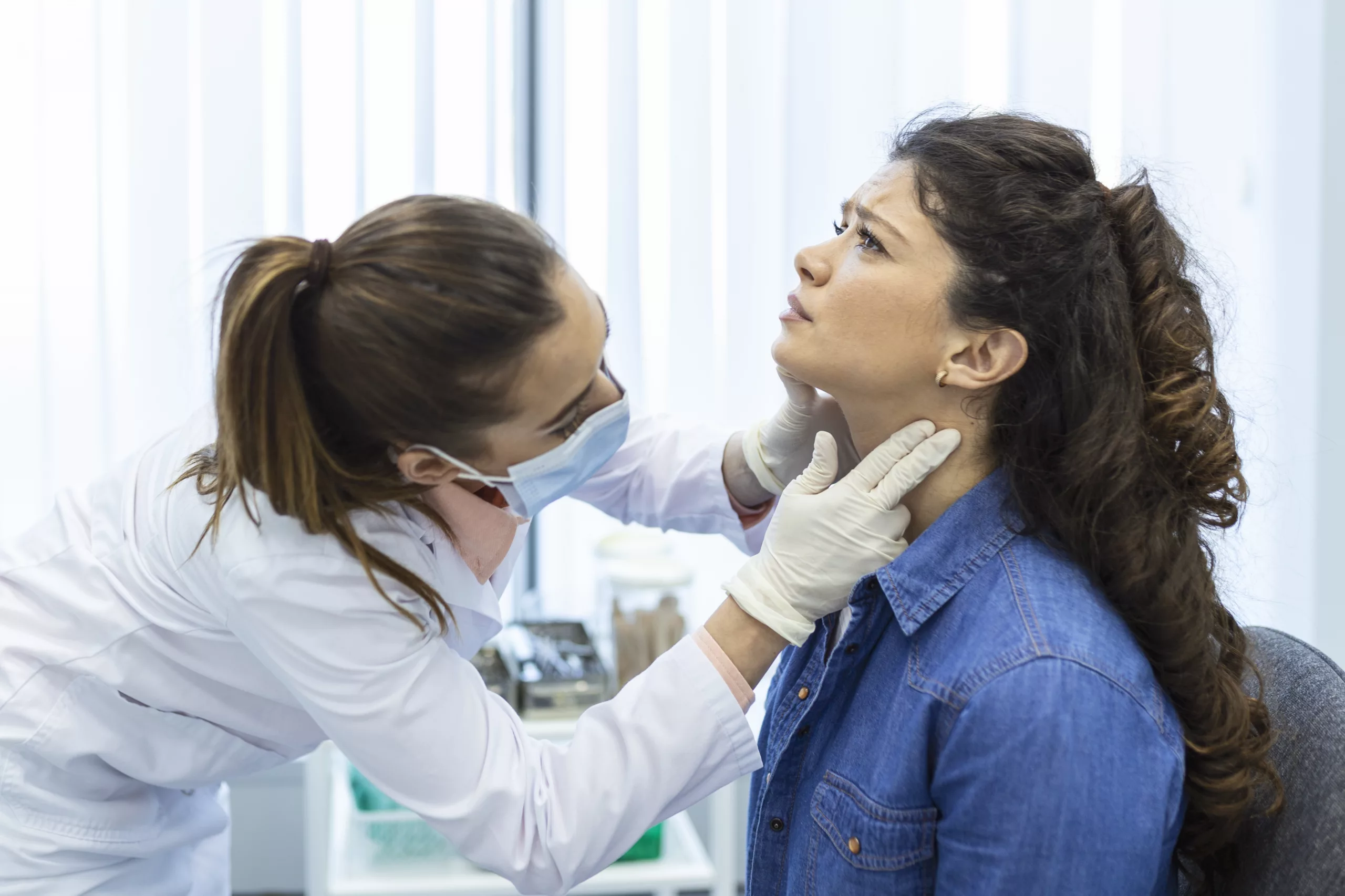Hashimoto’s Thyroiditis, also known as autoimmune thyroiditis or chronic lymphocytic thyroiditis, is a condition in which the immune system attacks the thyroid gland, leading to decreased thyroid hormone production (hypothyroidism). The thyroid is a small two-winged gland in the neck that secretes hormones responsible for regulating body metabolism and maintaining energy levels. These hormones play a crucial role in the functioning of all body organs. However, in this disease, the thyroid hormonal level gets disturbed, causing abnormal functioning of body organs.
Autoimmune diseases involve the immune system mistakenly identifying healthy cells within the body as foreign entities and launching an attack against them, resulting in their destruction. In the context of this disorder, the immune system perceives the thyroid as an external element and initiates the production of antibodies that target the thyroid. The resultant assault on the thyroid impairs its ability to release thyroid hormone adequately. As a result, the body experiences a deficiency in thyroid hormones, which manifests in many clinical symptoms.
Low thyroid hormone levels decrease the body’s metabolic rate. As a result, patients manifest symptoms like weight gain, being very sensitive to the cold, a lethargic body, lack of energy, and weak muscles and bones. This disease affects almost all body cells and tissues. Because of its autoimmune nature, it is unlikely to cure permanently. However, to avoid the symptoms, one can take thyroid hormone from an external source through medications.
What is Hashimoto’s Thyroiditis?
Hashimoto’s thyroiditis is an autoimmune disorder where the immune system produces antibodies that specifically attack and harm thyroid cells. This immune response results in decreased levels of thyroid hormones in the bloodstream, a condition called hypothyroidism. Due to the persistent nature of the immune reaction and the challenge of restoring or enhancing the entire immune defense mechanism, Hashimoto’s thyroiditis is a chronic condition. Management of this condition involves lifelong medication to maintain a state of well-being and health for the affected individuals. Hashimoto’s Thyroiditis is the most common cause of hypothyroidism in developed countries. However, worldwide, iodine deficiency is the most common cause of hypothyroidism.
This disease is more prevalent in females aged between 30 to 50. The male-to-female ratio of this condition is 1:10.1Mincer DL, Jialal I. Hashimoto Thyroiditis. [Updated 2023 Jul 29]. In: StatPearls [Internet]. Treasure Island (FL): StatPearls Publishing; 2024 Jan-. Available from: https://www.ncbi.nlm.nih.gov/books/NBK459262/ The presence of Hashimoto’s thyroiditis in the family increases a person’s chances of getting this autoimmune illness.2Hu, X., Chen, Y., Shen, Y., Tian, R., Sheng, Y., & Que, H. (2022). Global prevalence and epidemiological trends of Hashimoto’s thyroiditis in adults: A systematic review and meta-analysis. Frontiers in public health, 10, 1020709. https://doi.org/10.3389/fpubh.2022.1020709
Causes of Hashimoto’s Thyroiditis
There are multiple causes of Hashimoto’s Thyroiditis, including genetic, environmental, and health-related factors:
- Genetic: A Greater number of patients show a strong family history of this autoimmune disorder. The presence of autoimmune disorders like celiac disease and lupus erythematosus in the body enhances the risk of autoimmune thyroiditis.
- Gender Dominance: Hashimoto’s thyroiditis is more prevalent in women.3Caturegli, P., De Remigis, A., & Rose, N. R. (2014). Hashimoto thyroiditis: clinical and diagnostic criteria. Autoimmunity reviews, 13(4-5), 391–397. https://doi.org/10.1016/j.autrev.2014.01.007
- Infections: Multiple infectious agents, such as the retrovirus, herpes virus, and hepatitis C virus, can trigger Hashimoto’s Thyroiditis.
- Stress: Research has shown that extreme stress levels in the body trigger abnormal gland functioning.4Mizokami, T., Wu Li, A., El-Kaissi, S., & Wall, J. R. (2004). Stress and thyroid autoimmunity. Thyroid: Official Journal of the American Thyroid Association, 14(12), 1047–1055. https://doi.org/10.1089/thy.2004.14.1047
- Radiation exposure in the form of living near nuclear plants, working in a high radiation field like x-ray centers, and treatment intervention in the form of radiation can cause thyroid problems.
- Iodine-containing medications: Certain medications, such as those used in the treatment of heart conditions (like amiodarone) or bipolar disorder (such as lithium), can contribute to the development or exacerbation of Hashimoto’s Thyroiditis, particularly in individuals with underlying thyroid issues.
While the exact cause remain uncertain, these factors can initiate an immune response where antibodies attack healthy thyroid cells, leading to inflammation and impaired thyroid function.5Takami, H. E., Miyabe, R., & Kameyama, K. (2008). Hashimoto’s thyroiditis. World journal of surgery, 32(5), 688–692. https://doi.org/10.1007/s00268-008-9485-0

Clinical manifestation of Hashimoto’s Thyroiditis
The thyroid hormone plays a pivotal role in regulating the body’s metabolism and energy levels. In instances of hypothyroidism, there is a deceleration in the metabolic processes, leading to reduced energy production within the body. This manifests through a range of signs and symptoms:
- Weight gain – stemming from diminished metabolic functions
- Goiter – characterized by the abnormal enlargement of the thyroid gland due to misleading signals from the pituitary gland
- Sensations of bodily discomfort and fatigue
- Heightened sensitivity to cold temperatures
- Development of dry and patchy skin
- Thinning of hair
- Persistent drowsiness
- Overwhelming lethargy
- Irregular menstrual cycles in females
- Difficulty with bowel movements, often resulting in constipation
- Potential cardiac complications
In a few cases, damage to the thyroid gland leads to excessive release of thyroid hormone in the body, which causes hyperthyroidism. This feature lasts during the early stage, and afterward, the patient develops hypothyroidism. The intensity of symptoms varies in each patient and depends upon the lifestyle and dietary habits of the patient.6Mincer, D. L., & Jialal, I. (2022). Hashimoto Thyroiditis. In StatPearls. StatPearls Publishing.
Diagnosis of Hashimoto’s Thyroiditis
It is typically diagnosed through a combination of medical history, physical examination, and laboratory tests. Here’s an overview of the diagnostic process:
Detailed History
Patients are advised to give an accurate history to their clinicians and mention any family record of this disease, as well as any sensitivity to food products like gluten.
General Physical Examination
It includes checking all physical signs on the patient’s body. Special focus should be made on palpating the thyroid gland in the front of the neck.

Blood testing
The main blood tests used to diagnose Hashimoto’s thyroiditis are:
- Thyroid Function Tests: These tests measure the levels of thyroid hormones (T3 and T4) and thyroid-stimulating hormone (TSH) in the blood. In Hashimoto’s thyroiditis, T3 and T4 levels are typically low, while TSH levels are elevated due to the pituitary gland’s attempt to stimulate the thyroid.
- Thyroid Antibody Tests: Tests for antibodies associated with Hashimoto’s, such as antithyroid peroxidase (TPOAb) and antithyroglobulin antibodies (TgAb). The presence of these antibodies indicates an autoimmune response targeting the thyroid.7Klubo-Gwiezdzinska, J., & Wartofsky, L. (2022). Hashimoto thyroiditis: an evidence-based guide to etiology, diagnosis and treatment. Polish archives of internal medicine, 132(3), 16222. https://doi.org/10.20452/pamw.16222
Ultrasound
An ultrasound of the thyroid gland can reveal its size, shape, and any abnormalities, such as the presence of nodules or inflammation. This can help differentiate Hashimoto’s thyroiditis from other thyroid conditions.
In some cases, a fine-needle aspiration biopsy may be performed. This involves using a thin needle to extract a small tissue sample from the thyroid gland. The sample is then examined under a microscope to confirm the diagnosis and rule out other conditions like thyroid cancer.

Treatment intervention for Hashimoto’s Thyroiditis
As an autoimmune disorder, achieving a complete cure for the condition is not currently feasible. However, the most effective approach involves employing pharmacological interventions to address symptoms and uphold optimal thyroid hormone levels.
A fundamental aspect of treatment involves hormone replacement therapy. This entails introducing synthetic hormones sourced from external pharmaceuticals into the body via medication. This compensates for the shortage of natural hormones, allowing normal bodily function to resume. Among the pharmaceutical options, levothyroxine sodium stands out as the preferred choice. This medication mimics the actions of natural thyroid hormones, rectifying their deficiency. The appropriate dosage of levothyroxine sodium varies according to factors such as age and individual physiological requirements. Additionally, meticulous monitoring of the medication’s dosage is imperative to mitigate the potential for any adverse effects.
Support Strategies for Hashimoto’s Thyroiditis
As patients need to take medication for a lifetime period, many patients prefer a natural approach to avoid the symptoms and escape complications. Thus, the natural approaches include taking a gluten-free diet, avoiding milk and related products, and avoiding stress.8Mikulska, A. A., Karaźniewicz-Łada, M., Filipowicz, D., Ruchała, M., & Główka, F. K. (2022). Metabolic Characteristics of Hashimoto’s Thyroiditis Patients and the Role of Microelements and Diet in the Disease Management – Overview. International journal of molecular sciences, 23(12), 6580. https://doi.org/10.3390/ijms23126580
Dietary Habits for Patients of Hashimoto’s Thyroiditis
Individuals diagnosed with Hashimoto’s thyroiditis are advised to steer clear of diets containing gluten and sugar, which encompasses ingredients like wheat, grains, refined sugar, caffeine, legumes, food additives, and alcohol. These substances have the potential to incite autoimmune responses within the body. Individuals can mitigate the risk associated with this condition by deliberately excluding these items from their diet. Instead, opting for an intake of anti-inflammatory foods such as leafy green vegetables, fruits, and a variety of spices is recommended. Moreover, to foster overall well-being, incorporating nourishing fats, fish oil, and foods rich in fiber into their diet is highly encouraged.
Supplements for Hashimoto’s Thyroiditis
Patients should be given supplements that help the patients to reduce the trigger and combat the inflammatory process. Supplements of vitamin D, iron, magnesium, selenium, and vitamin B complex will help patients to live a healthy life.9Zhang, J., Chen, Y., Li, H., & Li, H. (2021). Effects of vitamin D on thyroid autoimmunity markers in Hashimoto’s thyroiditis: systematic review and meta-analysis. The Journal of International Medical Research, 49(12), 3000605211060675. https://doi.org/10.1177/03000605211060675 Additionally, patients should take omega-3 capsules and probiotics to overcome the inflammatory process.10Ihnatowicz, P., Drywień, M., Wątor, P., & Wojsiat, J. (2020). The importance of nutritional factors and dietary management of Hashimoto’s thyroiditis. Annals of agricultural and environmental medicine: AAEM, 27(2), 184–193. https://doi.org/10.26444/aaem/112331
Complications – Hashimoto’s Thyroiditis
Hashimoto’s thyroiditis gives rise to a plethora of issues, each stemming from the autoimmune disruption it triggers. Hypothyroidism, a direct consequence of the autoimmune assault on the thyroid gland, brings about a range of distressing symptoms such as fatigue, weight gain, and heightened sensitivity to cold. Additionally, the condition can manifest as a goiter, leading to a noticeable swelling at the base of the neck. Another manifestation, myxedema, contributes to the development of puffiness around the eyes and skin. The implications of Hashimoto’s thyroiditis can extend to even more serious outcomes, including heart problems and cognitive decline.
Fortunately, timely medical intervention through thyroid hormone replacement therapy can rectify thyroid hormone levels. This proactive approach alleviates the symptoms associated with the disorder and effectively mitigates the risks of these complications, promoting an overall enhancement of well-being.
COVID-19 and Hashimoto’s Thyroiditis
Research has shown a greater link between COVID-19 and exacerbating hypothyroidism caused by Hashimoto’s thyroiditis. Hence, the reason lies in the fact that the presence of coronavirus infection produces an inflammatory response in the body, which triggers autoimmune illness.
As Hashimoto’s thyroiditis is an autoimmune illness, patients experience the severity of symptoms after contracting covid 19.11Tee, L. Y., Harjanto, S., & Rosario, B. H. (2021). COVID-19 complicated by Hashimoto’s thyroiditis. Singapore Medical Journal, 62(5), 265. https://doi.org/10.11622/smedj.2020106

In conclusion, Hashimoto’s thyroiditis, characterized by its autoimmune nature, manifests symptoms primarily due to insufficient thyroid hormone levels. However, the most effective and prevailing approach to managing this condition remains the implementation of lifelong hormone replacement therapy. This treatment not only addresses the underlying hormonal imbalance but also empowers individuals to lead fulfilling and healthier lives despite the challenges posed by this chronic disorder.
Refrences
- 1Mincer DL, Jialal I. Hashimoto Thyroiditis. [Updated 2023 Jul 29]. In: StatPearls [Internet]. Treasure Island (FL): StatPearls Publishing; 2024 Jan-. Available from: https://www.ncbi.nlm.nih.gov/books/NBK459262/
- 2Hu, X., Chen, Y., Shen, Y., Tian, R., Sheng, Y., & Que, H. (2022). Global prevalence and epidemiological trends of Hashimoto’s thyroiditis in adults: A systematic review and meta-analysis. Frontiers in public health, 10, 1020709. https://doi.org/10.3389/fpubh.2022.1020709
- 3Caturegli, P., De Remigis, A., & Rose, N. R. (2014). Hashimoto thyroiditis: clinical and diagnostic criteria. Autoimmunity reviews, 13(4-5), 391–397. https://doi.org/10.1016/j.autrev.2014.01.007
- 4Mizokami, T., Wu Li, A., El-Kaissi, S., & Wall, J. R. (2004). Stress and thyroid autoimmunity. Thyroid: Official Journal of the American Thyroid Association, 14(12), 1047–1055. https://doi.org/10.1089/thy.2004.14.1047
- 5Takami, H. E., Miyabe, R., & Kameyama, K. (2008). Hashimoto’s thyroiditis. World journal of surgery, 32(5), 688–692. https://doi.org/10.1007/s00268-008-9485-0
- 6Mincer, D. L., & Jialal, I. (2022). Hashimoto Thyroiditis. In StatPearls. StatPearls Publishing.
- 7Klubo-Gwiezdzinska, J., & Wartofsky, L. (2022). Hashimoto thyroiditis: an evidence-based guide to etiology, diagnosis and treatment. Polish archives of internal medicine, 132(3), 16222. https://doi.org/10.20452/pamw.16222
- 8Mikulska, A. A., Karaźniewicz-Łada, M., Filipowicz, D., Ruchała, M., & Główka, F. K. (2022). Metabolic Characteristics of Hashimoto’s Thyroiditis Patients and the Role of Microelements and Diet in the Disease Management – Overview. International journal of molecular sciences, 23(12), 6580. https://doi.org/10.3390/ijms23126580
- 9Zhang, J., Chen, Y., Li, H., & Li, H. (2021). Effects of vitamin D on thyroid autoimmunity markers in Hashimoto’s thyroiditis: systematic review and meta-analysis. The Journal of International Medical Research, 49(12), 3000605211060675. https://doi.org/10.1177/03000605211060675
- 10Ihnatowicz, P., Drywień, M., Wątor, P., & Wojsiat, J. (2020). The importance of nutritional factors and dietary management of Hashimoto’s thyroiditis. Annals of agricultural and environmental medicine: AAEM, 27(2), 184–193. https://doi.org/10.26444/aaem/112331
- 11Tee, L. Y., Harjanto, S., & Rosario, B. H. (2021). COVID-19 complicated by Hashimoto’s thyroiditis. Singapore Medical Journal, 62(5), 265. https://doi.org/10.11622/smedj.2020106

